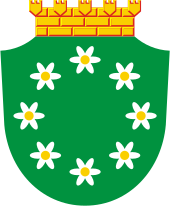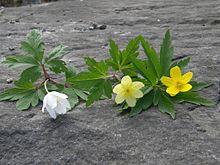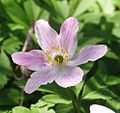Anemonoides nemorosa
| Anemonoides nemorosa | |
|---|---|

| |
| Scientific classification | |
| Kingdom: | Plantae |
| Clade: | Tracheophytes |
| Clade: | Angiosperms |
| Clade: | Eudicots |
| Order: | Ranunculales |
| Family: | Ranunculaceae |
| Genus: | Anemonoides |
| Species: | A. nemorosa
|
| Binomial name | |
| Anemonoides nemorosa (L.) Holub
| |

| |
| Synonyms[1] | |
| |
Anemonoides nemorosa(syn.Anemone nemorosa), thewood anemone,is an early-springflowering plantin thebuttercupfamilyRanunculaceae,native toEurope.[1]Other common names includewindflower,European thimbleweed,[2]andsmell fox,an allusion to the musky smell of the leaves.[3]It is aperennialherbaceousplant growing 5–15 cm (2–6 in) tall.
Description
[edit]
Anemonoides nemorosais arhizomatousherbaceous perennialplant less than 30 centimetres (12 in) in height. The compound basal leaves are palmate or ternate (divided into three lobes).[4]: 106 They grow from underground root-like stems calledrhizomesand die back down by mid summer (summer dormant).
The plants start blooming in spring, March to May in theBritish Isles[5]: 28 soon after the foliage emerges from the ground. Theflowersare solitary, held above the foliage on short stems, with a whorl of three palmate or palmately-lobed leaflike bracts beneath. The flowers are 2 centimetres (0.8 in) diameter, with six or seven (and on rare occasions eight to ten)tepals(petal-like segments) with manystamens.In the wild the flowers are usually white but may be pinkish, lilac or blue, and often have a darker tint on the backs of the tepals.
Similar species
[edit]Theyellow wood anemone(Anemonoides ranunculoides) is slightly smaller, with yellow flowers and usually without basal leaves.[4]
Wood sorrelOxalis acetosella,which grows in similar shaded places, can be readily distinguished by its 3-parted, clover-like leaves and smaller flowers with only white petals and 5 sepals.[5][6]
Distribution and habitat
[edit]
The native range ofAnemonoides nemorosaextends acrossEuropeto westernAsia,reaching as far south as theCaucasus MountainsinTurkey.It has been introduced intoNew Zealandand elsewhere.[1]InNorth America,there are naturalized populations at well-known sites inNewfoundland,Quebec,andMassachusetts.[7][8]
A. nemorosais often found in shady woods.[6]The species is common in theBritish Isles[5]but it spreads very slowly there, by as little as six feet per century, so it is often used as an indicator for ancient woodland.[9]
Ecology
[edit]
The flowers arepollinatedby insects, especiallyhoverflies.[10]The seeds are achenes.[4]
In cultivation
[edit]Manycultivarshave been selected for garden use, TheRHS Plant Finder 2008–2009lists 70 cultivars sold by nurseries in the UK. Some of the most widely available are:

- 'Alba Plena' - double white
- 'Allenii'agm[11]- large lavender-blue flowers, often with seven petals (named afterJames Allen,nurseryman)
- 'Bowles' Purple' - purple flowers (named afterE.A. Bowles,plantsman and garden writer)
- 'Bracteata Pleniflora' - double, white flowers, with green streaks and a frilly ruff ofbracts
- 'Robinsoniana'agm[12]- pale lavender-blue flowers (named afterWilliam Robinson,plantsman and garden writer)
- 'Royal Blue' - deep blue flowers with purple backs
- 'Vestal'agm[13]- white, anemone-centred flowers
- 'Virescens'agm[14]- flowers mutated into small conical clusters of leaves
Those markedagmare recipients of theRoyal Horticultural Society'sAward of Garden Merit.
Anemonoides×lipsiensis,a hybrid betweenA. nemorosaandA. ranunculoides,[15]has pale yellow flowers;A.×lipsiensis'Pallida' is the best-known result of this cross. It has also been awarded the AGM.[16]
Gallery
[edit]-
Anemonoides nemorosain Flemingsbergsskogens naturreservat, Sweden
-
Form inChemnitz,Germany
-
Colonial growth in forest,Radziejowice,Poland
-
Double-flowered cultivar inLincolnshire,England
-
Pink-flowered plant inHohenlohe,Germany
-
Flowers with six, seven, eight and nine tepals
-
A flowering wood anemone.
-
Half-opened fragile flower bud of a Anemonoides nemorosa.
References
[edit]- ^abc"Anemonoides nemorosa(L.) Holub ".Plants of the World Online.Royal Botanic Gardens, Kew.Retrieved21 July2020.
- ^"Anemone nemorosa Wood Anemone, European thimbleweed PFAF Plant Database".Plants for a Future.Retrieved2022-02-01.
- ^"Wood anemone".UPM Forest Life.2019-05-13.Retrieved2022-02-01.
- ^abcStace, C. A.(2010).New Flora of the British Isles(Third ed.). Cambridge, U.K.: Cambridge University Press. p. 88.ISBN978-0-521-70772-5.
- ^abcClapham AR, Tutin TG, Warburg EF (1981).Excursion Flora of the British Isles(3 ed.). Cambridge University Press.ISBN0-521-23290-2.
- ^abParnell, J. and Curtis, T. 2012.Webb's An Irish Flora.Cork University Press.ISBN978-185918-4783
- ^Dutton, Bryan E.; Keener, Carl S.; Ford, Bruce A. (1997)."Anemone".In Flora of North America Editorial Committee (ed.).Flora of North America North of Mexico (FNA).Vol. 3. New York and Oxford: Oxford University Press.Retrieved2020-11-28– via eFloras.org,Missouri Botanical Garden,St. Louis, MO &Harvard University Herbaria,Cambridge, MA.
- ^"Anemone nemorosa".County-level distribution map from the North American Plant Atlas (NAPA).Biota of North America Program (BONAP). 2014.Retrieved28 November2020.
- ^"Plantlife - Wood Anemone".Archived fromthe originalon 2021-03-08.Retrieved2018-10-17.
- ^Blank, S. and M. Wulf.on seed production and pollinator biology ofAnemone nemorosa(Buschwindröschen).Leibniz-Centre for Agricultural Landscape Research(ZALF). 2008.
- ^"Anemone nemorosa'Allenii'".RHS.Retrieved12 April2020.
- ^"Anemone nemorosa'Robinsoniana'".RHS.Retrieved12 April2020.
- ^"Anemone nemorosa'Vestal'".RHS.Retrieved12 April2020.
- ^"Anemone nemorosa'Virescens'".RHS.Retrieved12 April2020.
- ^Astuti, Giovanni; Marconi, Giancarlo; Pupillo, Paolo; Peruzzi, Lorenzo (17 May 2019)."Anemonoides×lipsiensiscomb. nov. (Ranunculaceae), new for the Italian flora ".Italian Botanist.7:101–105.doi:10.3897/italianbotanist.7.35004.Retrieved21 July2020.
- ^"Anemone×lipsiensis'Pallida'".RHS.Retrieved12 April2020.
Further reading
[edit]- Shirreffs, D. A. 1985.Anemone nemorosaL.Journal of Ecology73: 1005-1020.
- Philip, C. (2008).Plant Finder 2008-2009.Dorling Kindersley.ISBN978-1-4053-3190-6.
- Plantlife - Wood AnemoneArchived2021-03-08 at theWayback Machine








